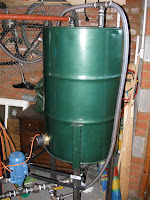So last night I decided to make something; - the coil for the methanol condenser.
The goal is to make a small coil of pipe to go inside a water jacket. The vapourised methanol gas goes in the top and condenses as it goes through. At the other end now liquid methanol is piped back into the can to be reused.
I have seen various condensers on the web, most seem to be very long and thin. One stood out by virtue of its shortness. The maker had coiled the pipe inside the water jacket, increasing the surface area (ie more efficient) and also reducing the height.
So, I obtained some 8mm copper pipe and a couple of end caps from a friendly local plumbing shop and filled it with very fine sand (which I had dried in the oven for 30 mins to make it easier to put in the pipe). The problem with copper pipe is that it pinches when bent. (think of a piece of hose pipe when folded) To get round this, plumbers use a spring inserted into the pipe to ensure the round profile is maintained as its bent.

The spring can then be twisted to shrink and release form the now bent pipe. the problem is that the coil I need is lots and lots of bends (the more bends, the harder to remove the spring), all one after another, plus the length of pipe I need (about 2 meters/6 feet) is too long to get a spring into and then back out of.
The solution is to use the old fashion way of pipe bending - fill it with sand and cap off at both ends (to stop the sand being pushed out by the bending force).
Once filled with sand, I found a highly engineered device to bend my pipe around - a can of windscreen de-icer! the diameter was about 2 1/2", just right for the 3" plastic pipe in am aiming to use for the water jacket.

Once bent to shape its time to remove the sand....
Removing the top and bottom end caps allows some of it out but the rest is compacted in pretty tightly. a gentle tap with a metallic object was enough to encourage some more of it out but in the end a swift rotating hand action (as you would do to get a yard of ale going - sorry for those of you who haven't been to an English pub for murky dish water drinking activities ;-) ). Out came the sand and I was left with an aesthetically pleasing piece of plumbing. Its a shame its going to go inside a plastic pipe and never be seen again!

 It looks pretty cloudy as there's still a few impurities in there. These will drop out (and be filtered out) once the left over methanol is removed. This is done through evaporation (from heating or naturally to the surrounding air). I heated this sample on the hob and took it to about 70c (around 160F) for 5 mins. Once it had cooled a little I decanted it (there was a distinct puddle of dark "stuff" (liquid and a few lumps) in the bottom) and filtered it through a coffee filter (Google suggests a coffee filter is around 20 microns).
It looks pretty cloudy as there's still a few impurities in there. These will drop out (and be filtered out) once the left over methanol is removed. This is done through evaporation (from heating or naturally to the surrounding air). I heated this sample on the hob and took it to about 70c (around 160F) for 5 mins. Once it had cooled a little I decanted it (there was a distinct puddle of dark "stuff" (liquid and a few lumps) in the bottom) and filtered it through a coffee filter (Google suggests a coffee filter is around 20 microns).





 In the foreground yo can see the input filter (Blue and white). This is where the first pump sucks in raw oil. If the oil has been used, it will need filtering, hence the 250 micron filter.
In the foreground yo can see the input filter (Blue and white). This is where the first pump sucks in raw oil. If the oil has been used, it will need filtering, hence the 250 micron filter.





 Lastly, I the welder has attacjed three box sections of steel to the sides of the tanks. Into these go the support legs to raise the tanks off the ground. Once in place the taks stand a little under 6 feet tall.
Lastly, I the welder has attacjed three box sections of steel to the sides of the tanks. Into these go the support legs to raise the tanks off the ground. Once in place the taks stand a little under 6 feet tall. 




 The caps are jointed to the pipe body with "no more nails" adhesive. If that fails I have some "plumber's mate" that sets on contact with water....
The caps are jointed to the pipe body with "no more nails" adhesive. If that fails I have some "plumber's mate" that sets on contact with water....
 The spring can then be twisted to shrink and release form the now bent pipe. the problem is that the coil I need is lots and lots of bends (the more bends, the harder to remove the spring), all one after another, plus the length of pipe I need (about 2 meters/6 feet) is too long to get a spring into and then back out of.
The spring can then be twisted to shrink and release form the now bent pipe. the problem is that the coil I need is lots and lots of bends (the more bends, the harder to remove the spring), all one after another, plus the length of pipe I need (about 2 meters/6 feet) is too long to get a spring into and then back out of.


